 This is NOT needed for day sailing
The purpose is to tension/flatten the jib luff upwind.
It is released off wind to allow fullness in the luff.
The free end has an 'S' hook to connect to a loop on the jib halyard wire.
One with this much purchase can, with blocks at the thwarts, bend the mast out
of column, promoting the upper section to bend off to leeward. Consult your
fav sail trim expert for why this is good and when.
This is NOT needed for day sailing
The purpose is to tension/flatten the jib luff upwind.
It is released off wind to allow fullness in the luff.
The free end has an 'S' hook to connect to a loop on the jib halyard wire.
One with this much purchase can, with blocks at the thwarts, bend the mast out
of column, promoting the upper section to bend off to leeward. Consult your
fav sail trim expert for why this is good and when.  You
really need to have a good suction bailer. An Elvtrom Super Medium is a good choice. Why? The Windmill is not a real dry
boat in a breeze and water sloshing around in the boat just invites a capsize.
Plus it allows the boat to drain when on the trailer.
This is an FG hull. Mount a bailer in the same place on a wood hull, just not too close
to the DB well, else you will skin your knuckles opening it.
You
really need to have a good suction bailer. An Elvtrom Super Medium is a good choice. Why? The Windmill is not a real dry
boat in a breeze and water sloshing around in the boat just invites a capsize.
Plus it allows the boat to drain when on the trailer.
This is an FG hull. Mount a bailer in the same place on a wood hull, just not too close
to the DB well, else you will skin your knuckles opening it. 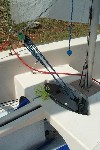 This
vang uses triple becket blocks. The free end is led
to the side tanks. See the blue and white line in the next photo.
This
vang uses triple becket blocks. The free end is led
to the side tanks. See the blue and white line in the next photo. A typical way control lines are rigged on the side tanks.
A typical way control lines are rigged on the side tanks.
They are usually led to dead end between the skipper and crew positions.
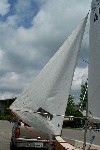
This is what a whisker pole looks like when set. [Well this one needs some breeze] Why do you need one? To go downwind. On broad reaches and dead down wind you need both the jib and main wing-and-wing to balance the boat. The more pressure on the main, the more you need the jib on the pole to balance the rig and keep the long pointy thingy vertical. How long should the pole be? About 84 inches. A fork for the mast end and a clip to attach to the loop of line on the jib clew.
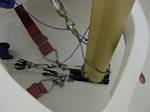 A very tidy maststep. Red nylon hiking straps attached to maststep,
as is the dead end of jib halyard puller. Note the vang can be
detached by unfastening the upper dealie.
A very tidy maststep. Red nylon hiking straps attached to maststep,
as is the dead end of jib halyard puller. Note the vang can be
detached by unfastening the upper dealie.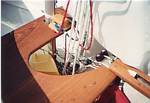 Another maststep, with all the trimmings. This is #5118, the handsome
creation of Kevin Kenitzer of KY.
Note the Harken cam cleat mounted on the AL plate just foreward of
the DB cap. This Terry Wood invention, is the jib halyard puller adjustment.
It's the perfect place for the cleat. The plate is bent downward
about 30 degrees so the cleat is below thwart level and it also
makes the angle of the pull just right.
Also note the "handle" on the mast chocks making them easy to
put in and out.
That large tan object in the right picture is the bailing bucket.
Yes, you will need one.
Another maststep, with all the trimmings. This is #5118, the handsome
creation of Kevin Kenitzer of KY.
Note the Harken cam cleat mounted on the AL plate just foreward of
the DB cap. This Terry Wood invention, is the jib halyard puller adjustment.
It's the perfect place for the cleat. The plate is bent downward
about 30 degrees so the cleat is below thwart level and it also
makes the angle of the pull just right.
Also note the "handle" on the mast chocks making them easy to
put in and out.
That large tan object in the right picture is the bailing bucket.
Yes, you will need one. 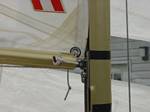
This is a Proctor mast and boom using a pin style gooseneck. The gooseneck is mounted to mast using a sail track which allows the boom height to be adjusted with the "screw" shown. Beware, of jibing in high winds with a sail track, I have seen them bend and come off the mast.
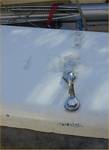
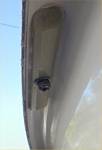
Shows the chainplates mounted in the extreme outboard postiion. Note the reinforcement under the deck lip. Unless you do this, your mast will come down one fine day. Use Teflon coated threads so the nut will not come off!
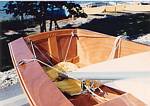
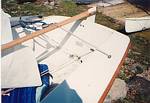
On the left, the transom of #5118. This boat uses a "pinching string" bridle. Note the nice detail of the rub rail! The boat on the right also uses a "pinching string" bridle. We really need pictures with the sails up to show how it works, there are lots of strings going all over the place.